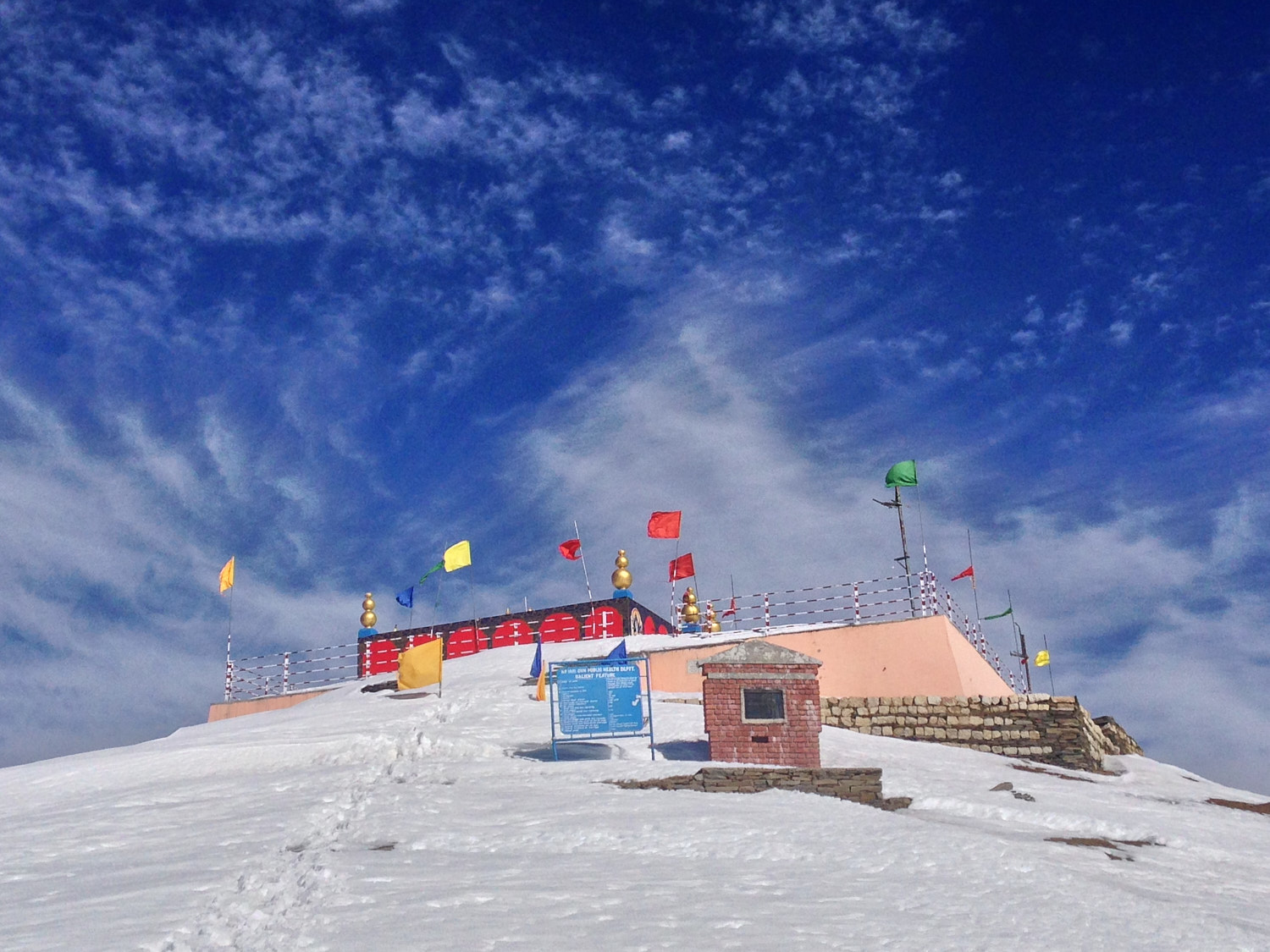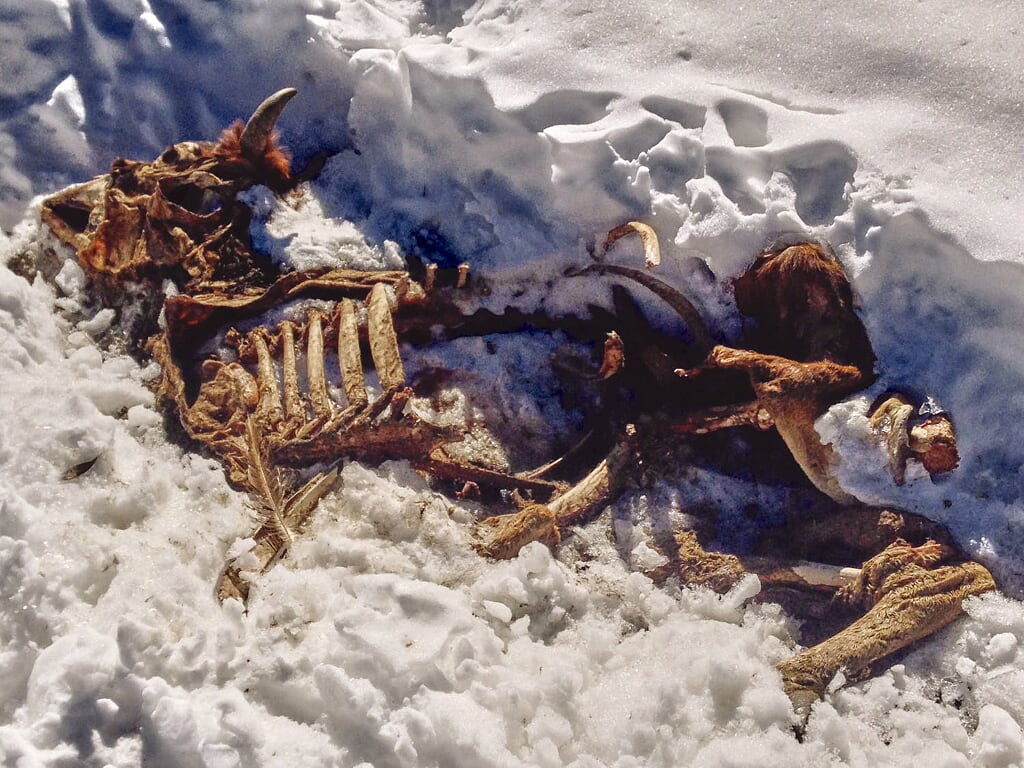Nag Tibba (Uttarakhand) trek diary part 3 of 3
This is the third and final part of the Nag Tibba trek journal. In the last part we (Amit & I) had just reached Nag Tibba and settled in for the night with a Gaddi Dera.
When Elephants Attack
It was the 6 of us over dinner camped near Nag Tibba Temple. The Gaddis regaled us with tales from their grazing season near Kotdwar (Uttarakhand). The jungles around Kotdwar are notorious for these wild pachyderms. These elephants wander the jungles and would barge in uninvited into Gaddi camps at night. Their booming trumpeting would shatter the still of the night and their rampage would cause the Gaddis to seek shelter on trees and in bushes. Although they didn’t damage or maim the flock, yet humans (especially those who’d been unkind to them) were fair game. Ram told us of that one time during an elephant rampage when he was paralyzed with fear, yet he had the wits to grab a young kid and throw himself under a prickly bush. The bleating kid egged the marauding elephants to go berserk, yet miraculously Ram escaped unhurt. To this day he reckons that it was his silent prayer to Lord Ganesha that helped him escape unscathed and with limbs intact.
 |
|---|
| Conversations with Gaddis over a few Beedi |
“Never insult an elephant, Ram tells me. Elephants are Ganesha (the Hindu elephant-headed god) and can sense an insult and will attack anyone rude or disrespectful to them. The only way to escape a rampaging elephant is to run in a zig-zag manner. An elephant being huge and ponderous will have difficulty keeping up with changing directions.”
I asked him if he had a chance to put his theory to the test, to which he replied in the negative. Although, he claims that this piece of Gaddi wisdom is passed on through the ages. Yet despite his reassuring tone, I’m sure that if an elephant does come running my way, I’d be busy wetting my pants than running a zig-zag pattern.
Maggi at Chinyali Thatch
Chinyali Thatch was elusive in April. The usual route from Jhandi Top was still covered in treacherous snow and slippery ice patches for over a hundred meters. Neither I nor Amit had any specialised footwear other than our trusted trail running shoes. Therefore we decided to approach Chinyali Thatch via an indirect “follow the ridge” route through Techta Thatch.
Thatch is a word for an alpine meadow used in the Garhwal region of Uttarakhand.
By the time we reached Chinyali, it was already mid-afternoon and we were both famished. While we were carrying noodles and drinking water, we didn’t have enough water left over for cooking. A meadow is often located close to a ridge top and ridges lack water sources. Fortunately the ice and snow that had barred our way earlier now came to our rescue. I decided to fetch some ice from a large ice patch and melt that ice for water to cook our noodles in. Buoyed by my idea, Amit quickly unpacked his cooking paraphernalia and set out to create a makeshift wood-burning stove. Nevertheless, my job was a bit more tricky as getting relatively untouched ice meant going further up an ice patch in trail runners. Not a very reassuring thing to do. After much tiptoeing, we had the saucepan bubbling with fresh ice water over a smoky bonfire. It was only once the water was boiling that Amit brought out his secret noodle ingredient. This was a premade chatni he never left home without. Created with oil, red chillies and infused with herbs and spices, it resembled Chamba’s famous Chukh.
Now I’m not a big instant noodle fan, yet that afternoon’s noodles were the best I’ve tasted in a long time. We spent the afternoon sitting against our backpacks, facing the beautiful Bandarpunch and Gangotri ranges and washing down the noodles with rich cups of hot chocolate.
Hidden water a.k.a. Gupt Paani
Most websites mention that drinking water is scarce around Nag Tibba. This is a fallacy. There is enough water around Nag Tibba to go around. Yet, you will have to descend 15-20 minutes from the trail to get to these water sources. Gaddis are lax in bringing their flock to slopes that do not have water. In case you find the water in the well at Nag Tibba temple to be murky, we recommend making a short detour towards Digon Thatch (see GPS logs in our trek details article), where a gushing mountain stream has fresh, refreshing water. I recommend carrying a portable water filter in your backpack as most of these water sources are shared between humans and their livestock alike. A Lifestraw ( [which I’ve reviewed and love]({% post_url 2015-04-18-Water-Filter-For-Hiking-Lifestraw-Review %}) comes in handy making these murky water sources drinkable.
Buy the Lifestraw on Amazon India.
In the GPS logs, you will find over 7 water sources around Nag Tibba including the very elusive “Gupt Paani”. Gupt Paani (literal translation: Hidden Water) is a small cove near Techta Thatch with spring water seeping through it. Gupt Paani is a perennial potable water source that is so well hidden that its secret is unknown to even most of the shepherds. The presence of water makes Techta Thatch an ideal camping ground if you’re looking to avoid the hustle and bustle of Nag Tibba Temple.
Avoiding large groups & trekking operators
Nag Tibba Temple is not a place for those seeking solitude, especially during weekends. The trekking season at Nag Tibba runs through the year. This implies that the usual camping spots used by organised trekking companies can get loud. Most organised trekking companies have groups that range from 15 to 40 or even bigger! If you’re seeking peace and quiet, I recommend camping at either Digon, Techta or Chinyali Thatch. All these meadows are off the main Nag Tibba trail that these organised trekking agencies follow. Almost certainly, you will have these meadows all to yourself or you will be sharing them with shepherds or goatherds. This is what I did each day that I spent at Nag Tibba. The views especially from Digon and Chinyali Thatch rival those from Jhandi Top with the added benefit of being more serene, quiet and cleaner.
 |
|---|
| Base Camp at Nag Tibba on a “less” busy weekend. You would not want to be here on a “regular” weekend. The large tents are toilet tents or staff tents put up by trekking operators |
Interesting Places Near Nag Tibba No Trekking Operator Will Tell You About
Nag Tibba summit or Jhandi Top is flanked by other smaller yet scenic meadows. Out of all these meadows, three deserve a special mention – Digon, Techta and Chinyali thatch.
Techta Thatch is the smallest meadow and lies due east of Jhandi Top. This meadow is worth visiting as it is the only meadow with its own water source, known in local parlance as “Gupt Paani”. It is an ideal place to camp due to its proximity to a water source. From Techta one can spot Surkanda Devi temple on the Dhanaulti ridge and also peek at the tower atop Lal Tibba.
More walks and treks around Lal Tibba and Mussoorie
The other two meadows worth visiting are Digon Thatch and Chinyali Thatch . Chinyali Thatch is the more scenic of the two with a better view of Bandarpunch and Gangotri Group. The view from Chinyali Thatch is better than what one gets from Jhandi Top.
 |
|---|
| Facing Bandarpoonch and Gangotri ranges from Chinyali Thatch |
A well-marked trail links Chinyali Thatch to the Dulleshwar Maharaj temple at Patharkhol. Patharkhol is a road-head on State Highway 6 that links Nainbagh to Pantwari and on to Uttarkashi. If you don’t fancy a walk back to Pantwari, this circuit of Pantwari village – Jhandi Top – Techta Thatch – Chinyali Thatch – Patharkhol makes for an interesting itinerary. Digon Thatch is Chinyali Thatch’s poor cousin. Despite this comparison, Digon Thatch has some spectacular views and is only a half-hour easy (child-friendly) walk from Nag Tibba forest bungalow. In addition to these views, the clearest and the biggest freshwater source in the Nag Tibba ridge lies halfway on the route to this meadow. This means you can enjoy some spectacular views and fill up your water bottles on the way back. Talk about killing two birds with one stone!
In addition to these meadows, the two ponds (or “taal” in local parlance) to the south of Nag Tibba temple deserve a special mention. These two ponds (chotta and bada taal — small and big ponds) are just off the Nag Tibba Temple – Devalsari trail. A substantial meadow decked with Gujjar huts surrounds these ponds. The ridge along the ponds has the best sunset views of Mussoorie and Lal Tibba. An immense white flecked rock face along the ridge is visible from Mussoorie at sunrise.




